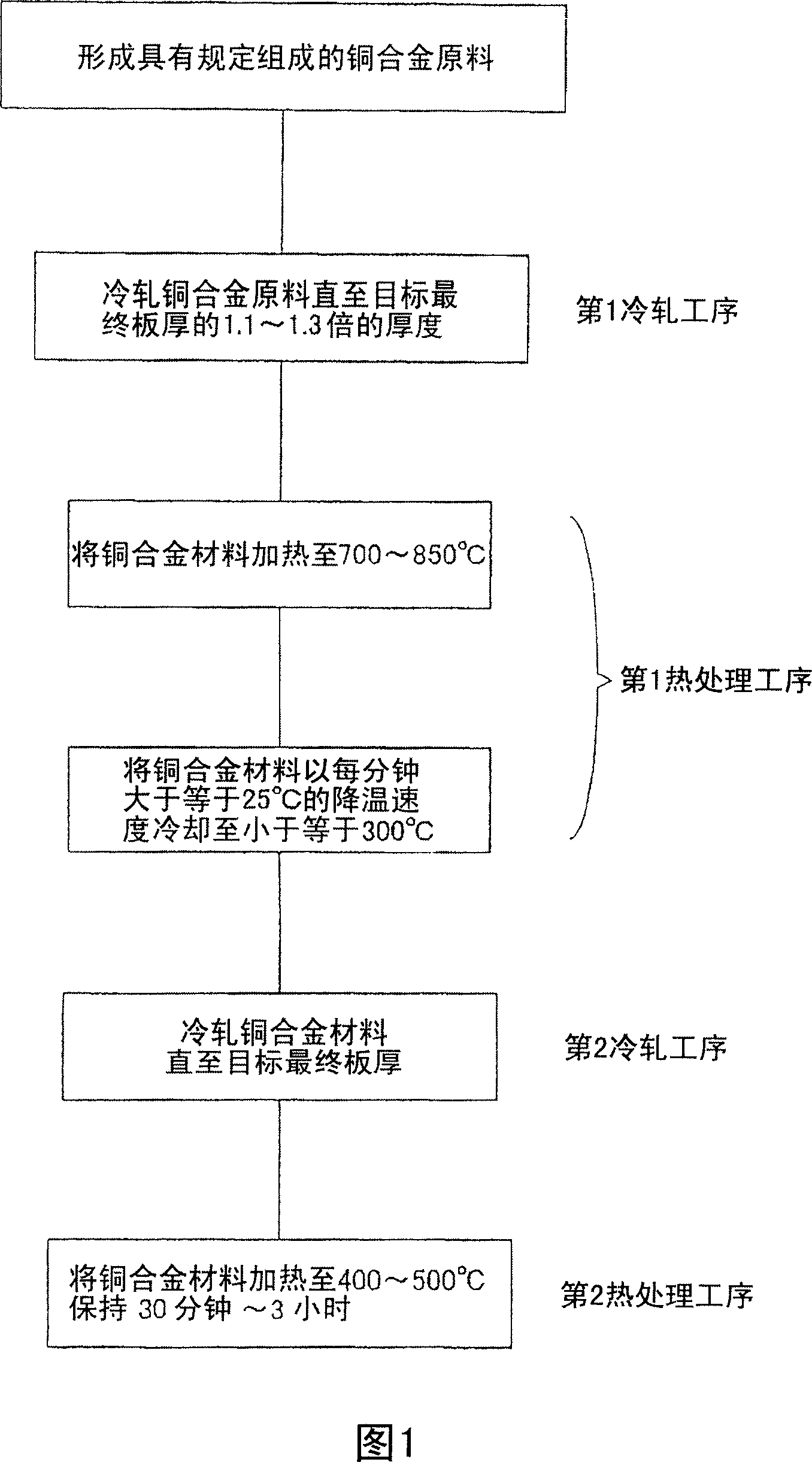Copper alloy material for electric element and method of making same
A technology for electrical components and manufacturing methods, applied in electrical components, cable/conductor manufacturing, metal rolling, etc., can solve the problems that phosphor bronze can not fully meet the performance, poor migration resistance, can not adapt to the increase of energization current, etc. Good bending properties, excellent elongation and electrical conductivity, and low anisotropy
- Summary
- Abstract
- Description
- Claims
- Application Information
AI Technical Summary
Problems solved by technology
Method used
Image
Examples
no. 1 Embodiment approach
[0018] Composition of copper alloy materials for electrical components
[0019] The copper alloy material for electrical components in this embodiment is characterized in that it contains 1.0 to 5.0% by mass of Ni, 0.2 to 1.0% by mass of Si, 0.05 to 2.0% by mass of Sn, and 0.1 to 5.0% by mass of Sn in its average composition. % of Zn, 0.01 to 0.3% by mass of P, a total of 0.05 to 1.0% by mass of at least one selected from Fe and Co, the balance being Cu and unavoidable impurities, the total mass of Ni, Fe and Co and Si The ratio [(Ni+Fe+Co) / (Si+P)] to the total mass of P is 4-10.
[0020] The reasons for adding and limiting the alloy components constituting the copper alloy material for electrical components such as terminals, connectors, and lead frames in this embodiment will be described below.
[0021] Adding Ni, Fe, Co together with Si and P will form Si compound and P compound and disperse and precipitate in the material. In the conventional Cu-Ni-Si alloy, the strengt...
no. 2 Embodiment approach
[0030] Composition of copper alloy materials for electrical components
[0031]The copper alloy material for electrical components in this embodiment is characterized in that it contains 1.0 to 5.0% by mass of Ni, 0.2 to 1.0% by mass of Si, 0.05 to 2.0% by mass of Sn, and 0.1 to 5.0% by mass of Sn in its average composition. % of Zn, 0.01 to 0.3 mass % of P, a total of 0.05 to 1.0 mass % of at least one selected from Fe and Co, a total of 0.01 to 1.0 mass % of at least one selected from Mg, Ti, Cr and Zr species, the balance is Cu and unavoidable impurities, and the ratio [(Ni+Fe+Co) / (Si+P)] of the total mass of Ni, Fe and Co to the total mass of Si and P is 4-10.
[0032] The reasons for adding and limiting the alloy components constituting the copper alloy material for electrical components in this embodiment will be described below.
[0033] The reasons for adding Ni, Si, Sn, Zn, P, Fe, and Co, and the reasons for specifying the content (addition amount) and composition ra...
Embodiment 1
[0053] Using oxygen-free copper as the base material, melted in a high-frequency melting furnace with Ni: 3.0 mass%, Si: 0.5 mass%, P: 0.15 mass%, Fe: 0.15 mass%, Co: 0.15 mass%, Sn: 1.0 mass %, Zn: a copper alloy composed of 1.5% by mass was cast into an ingot with a diameter of 30 mm and a length of 250 mm.
[0054] This was heated to 850° C. and extruded (hot worked) to form a plate shape with a width of 20 mm and a thickness of 8 mm to obtain a copper alloy raw material, which was then cold-rolled to a thickness of 0.36 mm (first cold rolling). Next, the cold-rolled material was held at 800° C. for 10 minutes, then poured into water, and subjected to a first heat treatment of cooling to room temperature (about 20° C.) at a rate of about 300° C. / min. Next, the cooled material was cold-rolled to a thickness of 0.3 mm (second cold rolling), and then the second heat treatment (sample No. 1) of holding at 470° C. for 2 hours was performed.
[0055] For the sample No. 1 produce...
PUM
| Property | Measurement | Unit |
|---|---|---|
| diameter | aaaaa | aaaaa |
| length | aaaaa | aaaaa |
| elongation | aaaaa | aaaaa |
Abstract
Description
Claims
Application Information
 Login to View More
Login to View More - R&D
- Intellectual Property
- Life Sciences
- Materials
- Tech Scout
- Unparalleled Data Quality
- Higher Quality Content
- 60% Fewer Hallucinations
Browse by: Latest US Patents, China's latest patents, Technical Efficacy Thesaurus, Application Domain, Technology Topic, Popular Technical Reports.
© 2025 PatSnap. All rights reserved.Legal|Privacy policy|Modern Slavery Act Transparency Statement|Sitemap|About US| Contact US: help@patsnap.com

